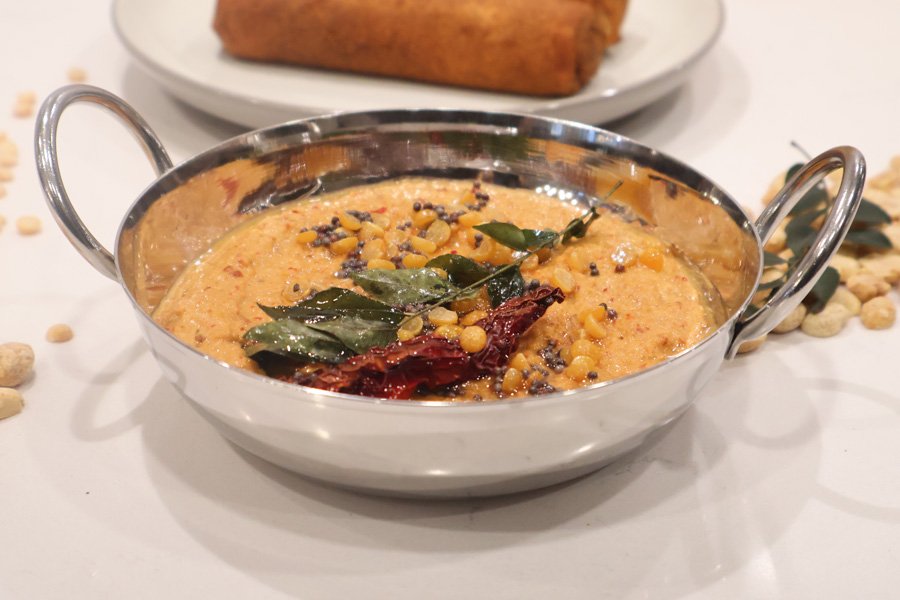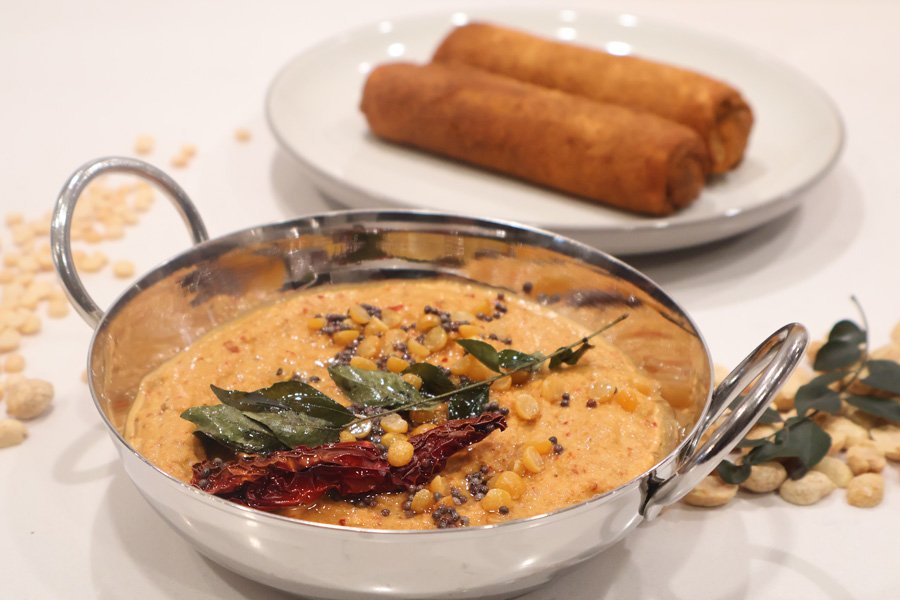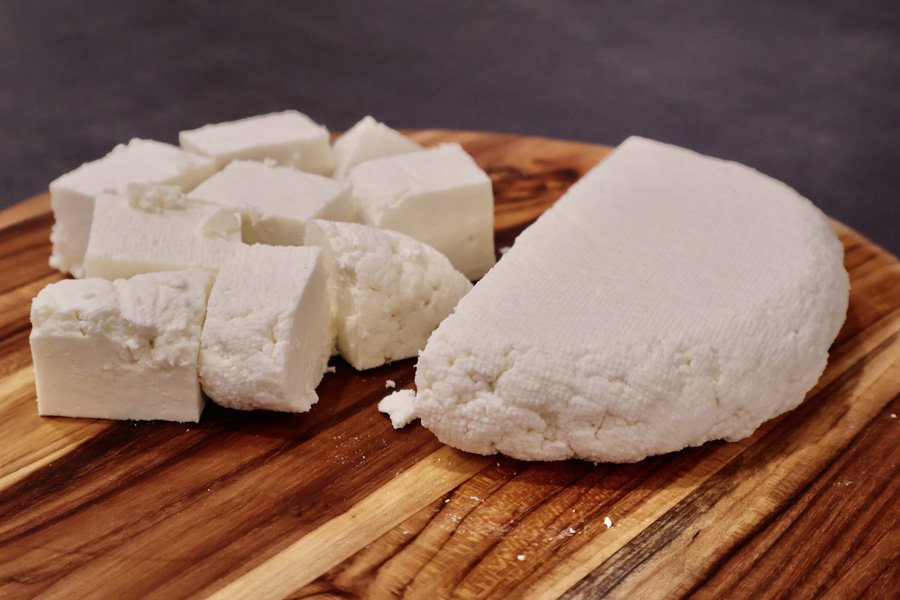Delicious South Indian Roasted Peanut Chutney Recipe
This post may contain affiliate links. Read our disclosure policy
Peanuts make for an amazing creamy base for this slightly sweet, spicy and tangy South Indian style chutney. This Indian Roasted Peanut Chutney recipe is perfect to pair with idlis, dosa, and fritters, this chutney is full of subtle aromatics that make this condiment a truly unique experience.
Watch How to Make Indian Roasted Peanut Chutney Here:
What is Peanut Chutney?
Peanut Chutney is an iconic South Indian condiment that features roasted peanuts, onions, garlic, and dried red chilies. It’s smoky with a subtle sweetness, and it’s paired with South Indian favourites such as dosa, idlis, and fritters. If South Indian cooking is new to you, then I suggest you make it no longer a destination unseen by pairing this South Indian Roasted Peanut Chutney with a main of your choice as part of your Live to Cook one-month challenge! Get started for free today by signing up to my email newsletter, plus all of my latest recipes will be delivered to you directly to your inbox so you’ve always got inspiration!
To follow along with all the steps outlined in this recipe, be sure to watch the video recipe! If you’re not already, please subscribe to my YouTube channel, and don’t forget to hit the bell button so you’re notified when all of my video recipes go live! Let’s get roasting!
Why You’ll Love this Roasted Peanut Chutney
Quick and easy to make: This Roasted Peanut Chutney only takes 15 minutes from start to finish, with a super quick prep time! You can make this chutney for any occasion!
Amazing texture: This South Indian Peanut Chutney can be blended to have a smooth texture, or you can leave it slightly coarse - that is the way that I like it and what I’ve shown here!
Packed with flavour: This South Indian Peanut Chutney recipe delivers on a bit of heat and some subtle sweetness for an amazing experience, rich in South Indian aromatics such as curry leaves and mustard seeds. The Kashmiri red chilies provide the heat with a North Indian twist to this South Indian delight.
Versatile chutney: There are plenty of ways to enjoy this simple peanut chutney recipe! Keep on reading for plenty of serving suggestions later on in this post!
Dietary Information for Indian Roasted Peanut Chutney
This Indian Roasted Peanut Chutney is…
Dairy-free
Gluten-free, if using certified gluten-free hing or by omitting it.
Questions You May Have
Is This Indian Roasted Peanut Chutney Recipe Healthy?
Yes, I would consider this Indian Roasted Peanut Chutney to be healthy! Peanuts are a nutritional powerhouse, loaded with protein and healthy fats. Peanuts are also high in many vitamins and minerals, including Vitamin E, magnesium, and phosphorous. Peanuts are a great source of antioxidants, and can assist in protecting against heart disease. If you want more information on the health benefits of peanuts, then you can check out this article.
Additionally, coconut oil is an excellent cooking oil, loaded with medium-chain triglycerides (MCTs), a kind of saturated fat. The MCTs that are present in coconut oil can assist with providing a quick supply of energy in a similar fashion that carbohydrates do. Additionally, MCTs can help reduce hunger. Coconut oil is also an excellent source of antioxidants, which can provide anti-inflammatory, anti-diabetic and brain health benefits. Get more information on the health benefits of coconut oil here.
Although this peanut chutney is higher in calories, remember that it is simply a condiment to be enjoyed with a main dish. You won’t be eating very much of this, so in moderation, this peanut chutney is indeed healthy and nutritious for you!
I Only Have Salted Peanuts! CaN I uSe That in This Roasted Peanut Chutney Recipe?
I actually used lightly seasoned roasted peanuts to make this Peanut Chutney recipe, so salted peanuts can definitely work here! As I describe in my free motivational guide to explore your potential in the kitchen, Make Cooking Fun!!, if you have a suitable substitute for an ingredient a recipe calls for, then there’s no reason to go out and buy exactly what is said! Either salted or unsalted peanuts will be perfectly fine to make our Indian Roasted Peanut Chutney! The only thing to consider is to be extra careful to taste the chutney before you add any added salt. If you are using unsalted peanuts, then you will need a little more salt. It is always important to salt to taste!
Do I Have to Use Coconut Oil For this Roasted Peanut Chutney?
I really love the flavour of coconut oil in this Roasted Peanut Chutney recipe, plus it’s a South Indian essential ingredient. However, if you don’t have coconut oil on hand or don’t want to use it for whatever reason, then don’t worry about it! The second option I’d choose if not using coconut oil would be ghee. However, keep in mind that if you use ghee to cook this Peanut Chutney recipe, then the chutney will no longer be vegan.
What If I don’t Have Chana Dal?
That’s no problem at all! If you don’t have chana dal, then there is no substitute. Simply don’t add anything here. The critical ingredients are the curry leaves, the red chilies, and the oil.
Can This Peanut Chutney Be Made without Garlic and Onion?
For context, Jainism is an ancient religion in India that is founded on the principles of non-violence, truth, and self-discipline. Folks who follow Jainism practice a strict vegetarian diet, and they avoid root vegetables such as garlic, onion, potatoes, and mushrooms to prevent harming small insects and microorganisms. As a result, individuals practicing Jainism may be curious if they can prepare this Roasted Peanut Chutney recipe without including garlic and onion. Furthermore, those who suffer from Irritable Bowel Syndrome (IBS) and other gastrointestinal diseases may have a hard time digesting garlic and onion, which are FODMAPs (fermentable oligosaccharides, disaccharides, monosaccharides and polyols); more specifically, garlic and onion contain high amounts of fructans, making these ingredients part of the Oligosaccharides FODMAP group.
With all that being said, technically you could make the Indian Peanut Chutney without incorporating garlic and onion. However, you’ll miss key flavours in the chutney, and it will not taste as good as its full potential. If you must omit these ingredients for your health or for your religious practice, then by all means do so!
Is there A Substitute For Curry Leaves In This Indian Peanut Chutney?
No, in this case there is really nothing you can do about curry leaves in our Indian Peanut Chutney recipe. There is nothing like curry leaves, and they are a critical ingredient for our peanut chutney recipe. Unfortunately, I really recommend you check out your local South Asian grocer or online to get the curry leaves! Don’t worry about the extra - they can easily be frozen and last a very long time in the freezer.
Tools Needed to Make Indian Peanut Chutney
Ingredients for Roasted Peanut Chutney
To see all ingredients FULL PRINTABLE recipe card, or by pressing the “Jump to Recipe” button. You can save the recipe for later and scale the recipe based on how much spicy momo chutney you want to make so that you’ve got the perfect amount of all ingredients, no mental math required!
For the Peanut Chutney
Peanuts: Whatever peanuts you have here will work. I used roasted and salted peanuts.
Coconut oil: To roast the peanuts and to sauté the base ingredients for the chutney.
Cumin seeds: Warm earthy aroma and once roasted, adds slight smokiness and complexity to the chutney.
Onions: Roughly diced and sautéed for added sweetness.
Kashmiri red chillies: Mild spiciness and lots of colour.
Garlic cloves: For a deep savoury flavour to balance the richness of the peanuts.
Tamarind: You want to use a small piece of tamarind that has soaked in warm water for at least 10 minutes.
Water: To help get the perfect consistency
Salt: Essential seasoning to taste.
For the Tadka
Coconut oil: To cook the ingredients for the tadka or tempering.
Kashmiri red chillies: Mild spiciness and lots of colour.
Chana dal: Adds a fun crispy texture to contrast the creaminess.
Curry leaves: A very distinct fresh South Indian essence, herbal and citrusy aroma.
Mustard seeds Adds a sharp pungent bite to enhance the overall depth of flavour.
Hing: Adds an umami like onion-garlic like aroma and aids with digestion.
How to Make Roasted Peanut Chutney
For the peanut chutney
Heat ½ tablespoon coconut oil in a pan over medium heat. Add peanuts and roast until golden brown and aromatic. Remove from the pan and set aside.
In the same pan, add the remaining ½ tablespoon coconut oil. Add cumin seeds, red onions, dried Kashmiri chilies, and garlic cloves. Sauté until the onions are soft and fragrant.
Remove from heat.
In a blender, combine the roasted peanuts, sautéed ingredients, soaked tamarind, ½ cup water, and salt to taste.
Blend until smooth. Add more water if needed for desired consistency.
For the tadka/tempering
Heat 1-2 teaspoons coconut oil in a small pan.
Add dried Kashmiri chilies, chana dal, mustard seeds, and hing.
When the mustard seeds start popping, add curry leaves and sauté for a few seconds.
Pour the tempering over the blended chutney and mix well.
Tips For A Super Flavourful Indian Roasted Peanut Chutney
Roast Peanuts well: Use low to medium heat to roast the peanuts evenly and stir continuously. If using pre-roasted peanuts, dry-roast them for a minute to refresh their flavour.
How to balance flavours in this Indian Roasted Peanut Chutney:
Tamarind: If the chutney is too tangy, reduce the tamarind or balance it with a pinch of jaggery or sugar.
Spice Level: Adjust the number of Kashmiri chilies based on heat preference. You can also mix Byadgi chilies, which are a type of mild South Indian red chili, primarily found in Karnataka, known for their deep red colour.
Salt: Always add salt as you go and ensure to taste after blending the peanut chutney mixture.
Tadka/Tempering Tips: Add mustard seeds first, and once they start popping, add the remaining ingredients. Curry leaves should be added last for the best aroma.
Texture: To achieve a smooth and creamy chutney, ensure to blend the Indian Peanut Chutney while the mixture is slightly warm.
Tempering tips: Keep the tadka oil hot before pouring it over the chutney for maximum flavor infusion.
How to Serve Indian Roasted Peanut Chutney
This Indian Roasted Peanut Chutney recipe would typically be served with South Indian staples, such as dosas, vadas, and idlis. However, there’s no need to stop there! This peanut chutney recipe can be quite versatile to use as a dip for a variety of breads, snacks and rice. Here are some ideas:
Breads: Rotis or parathas, or even stuffed parathas like Aloo Paratha, Paneer Paratha, Broccoli-Cheese Paratha, Gobhi Paratha, or Chicken Keema Paratha.
Snacks: Mushroom Puff Patty, Paneer Jalfrezi Samoas, Steamed Chicken Momos, Air Fryer Aloo Chaat, Aloo Cutlets.
Breakfast: South Indian Rava Upma, Besan Chilla, Indian-Spiced French Toast, North Indian Potato Brunch Rolls
Rice: Plain Basmati Rice, Jeera Rice, Pudina-Dhanya (Mint-Cilantro) Pulao, Turmeric Rice, Vegetable Pulao.
How to Store Roasted Peanut Chutney
To store your Roasted Peanut Chutney in the fridge, all you need to do is transfer the chutney into a mason jar or an airtight container. Because we have garlic in the chutney, I would not recommend that you keep it longer than 5 days.
To store the Roasted Peanut Chutney for longer, then you can definitely freeze it. You can freeze in small portions based on how much you plan to eat, and thaw as needed. Your peanut chutney will last for about 4 months in the freezer.
More Delicious Indian Chutney Recipes
Let me know what you think of this recipe in the comments! If you’ve tried this recipe, be sure to post it on social media and tag it with #cookingwithanadi and mention me @cooking.with.anadi. Thank you!

Indian Roasted Peanut Chutney
Peanuts make for an amazing creamy base for this slightly sweet, spicy and tangy South Indian style chutney. This Indian Roasted Peanut Chutney recipe is perfect to pair with idlis, dosa, and fritters, this chutney is full of subtle aromatics that make this condiment a truly unique experience.
Ingredients
- 1/2 Cup peanuts
- 1 Tbsp coconut oil
- 1/4 tsp cumin seeds
- 1/4 Cup red onions, diced
- 3-4 dried Kashmiri red chillies
- 3 garlic cloves
- small piece of tamarind, soaked in warm water for at least 10 minutes
- 1/2 Cup water
- salt to taste
- 1-2 tsp coconut oil
- 1-2 dried Kashmiri red chilies
- 1 tsp chana dal
- 5-6 curry leaves
- 1/2 tsp mustard seeds
- pinch of hing
Instructions
- Heat ½ tablespoon coconut oil in a pan over medium heat. Add peanuts and roast until golden brown and aromatic. Remove from the pan and set aside.
- In the same pan, add the remaining ½ tablespoon coconut oil. Add cumin seeds, red onions, dried Kashmiri chilies, and garlic cloves. Sauté until the onions are soft and fragrant.
- Remove from heat.
- In a blender, combine the roasted peanuts, sautéed ingredients, soaked tamarind, ½ cup water, and salt to taste.
- Blend until smooth. Add more water if needed for desired consistency.
- Heat 1-2 teaspoons coconut oil in a small pan.
- Add dried Kashmiri chilies, chana dal, mustard seeds, and hing.
- When the mustard seeds start popping, add curry leaves and sauté for a few seconds.
- Pour the tempering over the blended chutney and mix well.
Nutrition Facts
Calories
741Fat (grams)
58 gSat. Fat (grams)
23 gCarbs (grams)
45 gFiber (grams)
13 gNet carbs
31 gSugar (grams)
15 gProtein (grams)
26 gSodium (milligrams)
241 mgCholesterol (grams)
0 mgFollow me
Meet Anadi
Welcome to Cooking With Anadi. This platform is all about making cooking exciting and finding new ways to bring classic flavours and recipes at your service. Join me in my personal journey in the world of cooking. Hope you have a great ride!


























































































